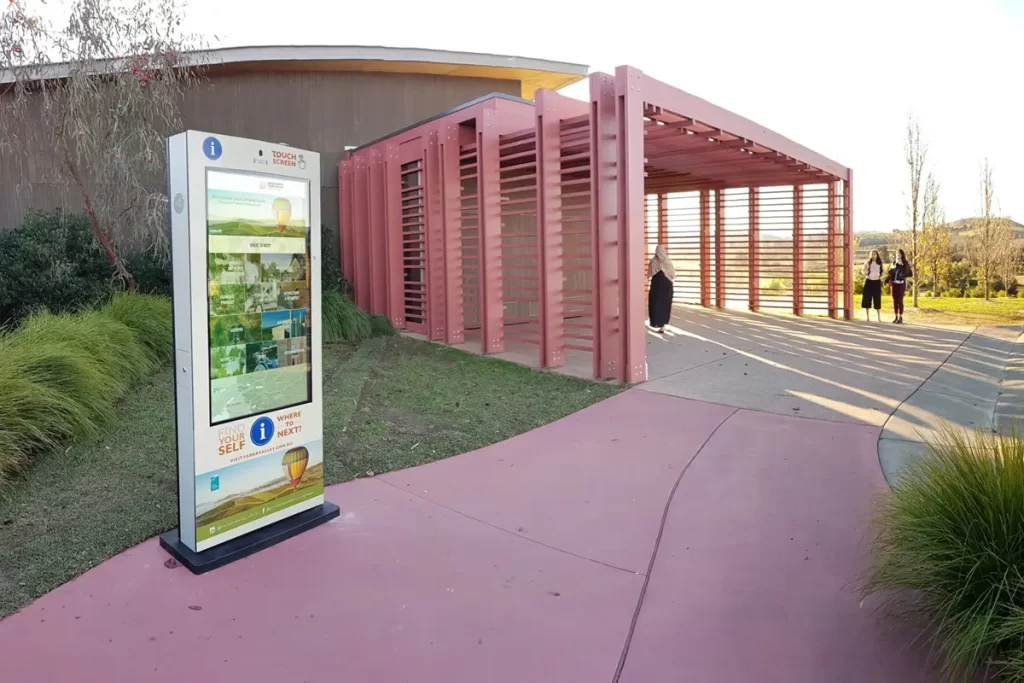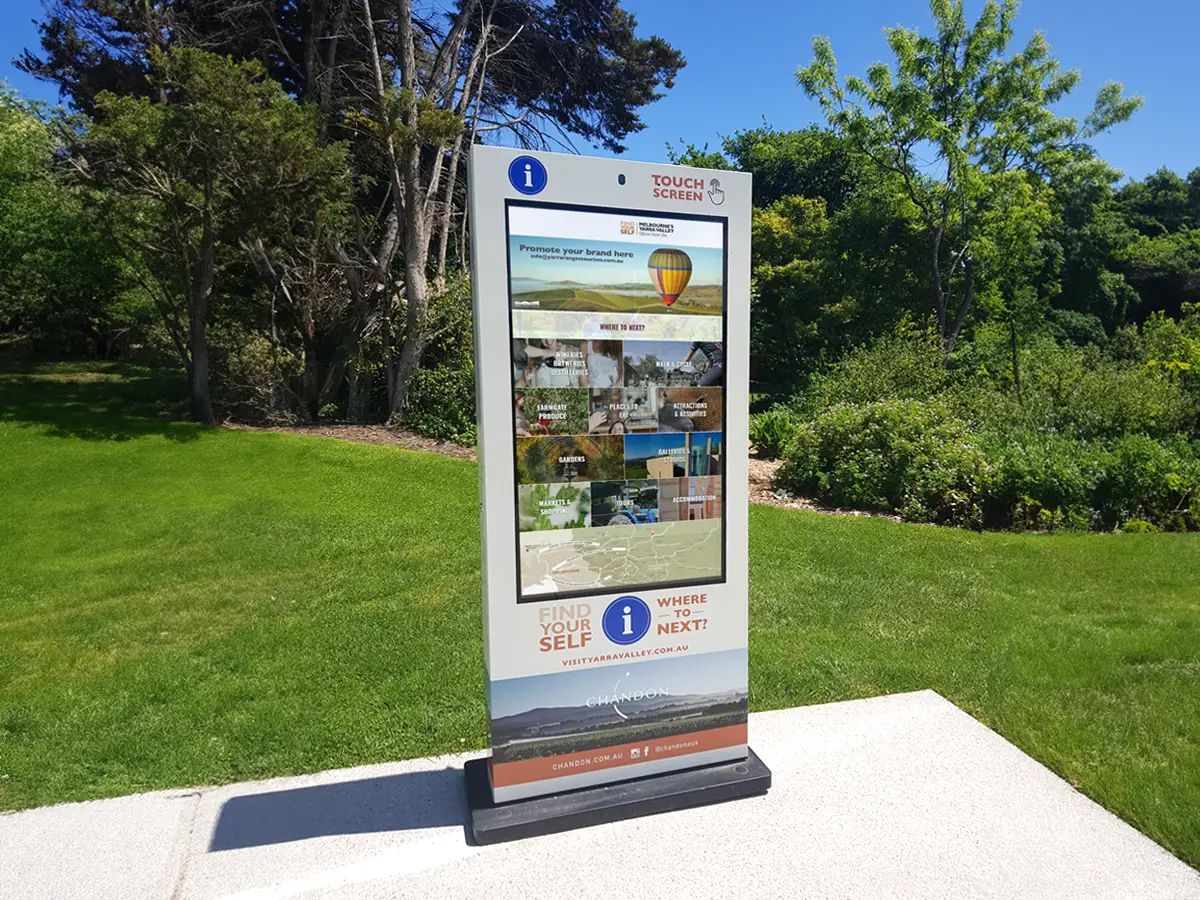
Embracing Technology in Tourism: The Rise of Digital Signage
It’s no secret that over the years technology has seamlessly blended into our daily lives – and the tourism industry is no exception. Known for its dynamic nature, tourism has always been quick to embrace any advancements, which has led to the adoption of innovative solutions such as digital signage. From interactive kiosks at airports to vibrant displays in hotel lobbies, digital signage is redefining how information is imparted to tourists. Its ability to provide real-time updates, maps, and event information in an engaging format makes it an invaluable tool. We explore the role of digital signage in enhancing the tourist experience, offering insights into how tourism organisations can leverage this technology to inform, guide and engage travellers.
Information at your Fingertips
Navigating with Ease
Navigating new places is one of the biggest challenges tourists face. Digital signage plays an important role here, with interactive maps and directions that are both user-friendly and informative. These digital displays, often found in airports, train stations, and city centres, provide tourists with a visual and interactive way to make sense of their surroundings.
Many digital signs are touchscreen, allowing tourists to interact with the map and actually zoom in on areas of interest, find specific directions, and even discover hidden gems in the city.
Some digital signage systems are also designed to integrate seamlessly with mobile devices. This means tourists can scan a QR code to transfer map information to their phones, making it even easier to get around and find the sights they are looking for.
Local Information and Tips
Digital signage is also your go-to spot for local information, displaying a variety of useful content, including local weather forecasts, cultural etiquette tips, emergency contact information, and public transportation schedules.
- Weather updates: Digital signage that displays real-time weather updates helps travellers prepare for their day, whether it's carrying an umbrella for a rainy afternoon or dressing appropriately for a heatwave.
- Cultural insights and safety tips: Digital signs can offer quick tips on local customs, dining etiquette, and areas to avoid, ensuring a respectful and safe travel experience.
- Real-time updates: The dynamic nature of digital signage means that any changes in public transport schedules, opening hours of attractions, or important announcements can be communicated instantly.

Event Updates and Promotions
Real-Time Event Information
From cultural festivals to local markets, events play a significant role in attracting visitors to a particular area. Digital signage is one of the best ways to provide real-time updates and information, ensuring tourists have the latest details at their fingertips.
Digital signs can display current schedules, locations and timings for various events. This means any last-minute changes can be provided. It is also a great way to let tourists know about any events happening around them, so they don’t miss out.
Some digital signage systems offer interactive features, allowing tourists to browse through event listings, read descriptions, and even view maps showing event locations so they can plan ahead.
Promotional Content: Boosting Local Businesses and Services
Digital signage is also a great tool for promoting local businesses, services and attractions, helping to boost the local economy.
- Highlighting local attractions and services: Restaurants, shops and local attractions can be featured on digital signs, giving tourists a broader view of their destination. They can search by cuisine and find all the local options to choose from, making their lives much easier while giving local businesses a boost.
- Tailored recommendations: Advanced digital signage systems can also display tailored recommendations based on the time of day, weather, or even upcoming local events. For example, promoting cosy cafes on a rainy day or surfing activities during sunny weather.
- User feedback and interaction: Some digital signage systems allow tourists to leave feedback, rate their experiences, or even bookmark places of interest. This provides valuable data to tourism operators for future improvements and also helps future tourists when choosing how to spend their time in an area and what places to visit.

Sustainability and Eco-Friendly Practices
Reducing Paper Waste
The environment is at the forefront of many concerns. Digital signage offers a sustainable alternative to traditional paper-based pamphlets and advertising materials in the tourism industry. The shift from printed brochures, maps and flyers to digital displays aligns with environmental sustainability goals while resonating with the growing eco-consciousness among travellers.
While the initial investment in digital signage may be higher than printed materials, the long-term savings in terms of reduced printing and distribution costs make it a cost-effective and environmentally friendly option.
The adoption of energy-efficient technologies in digital signage is another step towards sustainable tourism. Modern digital signs often utilise LED technology, which is known for its energy efficiency and long lifespan. Many also include smart power management features, such as automatic dimming in low-light conditions or shutting down during off-peak hours, further enhancing energy efficiency.

Challenges and Considerations
While digital signage offers numerous benefits to the tourism industry, it comes with its own set of challenges.
- Initial investment and cost: One of the biggest challenges is the initial financial outlay required for installing digital signage systems. This can be a significant barrier for many tourism operators, especially small businesses. This is why it’s important to consider the long-term benefits and cost savings.
- Maintenance and upkeep: Digital signage systems require regular maintenance and updates to ensure they function correctly and display current information. This ongoing upkeep can be a challenge, particularly for operators without technical expertise. Partnering with reliable service providers and planning for regular maintenance can mitigate this issue.
- Technological updates and obsolescence: The fast pace of technological advancement means that tourism operators need to stay up-to-date with new developments and be prepared to update or upgrade their systems to keep up with the latest trends and features.

Digital Signage in Tourism
From providing real-time information and interactive maps to enhancing visitor engagement through multimedia content, digital signage offers many benefits. By adopting this technology, tourism operators can exceed the expectations of modern tourists who seek convenience, engagement and personalised experiences. As the tourism industry continues to evolve, the role of digital signage will expand. With thoughtful planning, ongoing innovation, and a commitment to sustainability, digital signage can continue to play a pivotal role in shaping the future of tourism.
Are you ready to elevate your tourism business and provide an unparalleled experience for your visitors? Whether you're looking to enhance visitor engagement, provide real-time information, or promote local attractions and events, Enplug has the tools you need to succeed.
